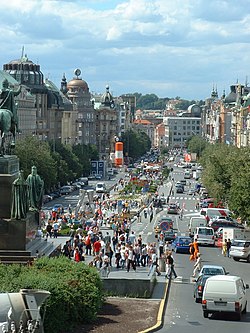Wenceslas Square
From Wikipedia, the free encyclopedia.
Wenceslas Square (Czech: Václavské náměstí) is the centre of the business and cultural communities in the New Town of Prague, Czech Republic. The English name is a misnomer, as Wenceslas Square is not really a square at all, but rather a 750-metre boulevard. It has been a place where many historical events occurred; it is also a traditional place for demonstrations, celebrations, and similar public gatherings. The square is named after Saint Wenceslas, the patron saint of the Czechs.
Contents |
Features
Wenceslas "Square" has a shape of a very long (750 m, total area 45,000 m²) rectangle, in a northwest–southeast direction. The street slopes upward to the southeast side. On that end, the street is bordered by the grand neoclassical Czech National Museum. The northwest end runs up against the border between the New Town and the Old Town.
The street is dominated by a mounted statue of Saint Wenceslas, made by Josef Václav Myslbek in 1887–1924 and located in front of the National Museum. The image of Saint Wenceslas is accompanied by other Czech patron saints carved into the ornate statue base: Saint Ludmila, Saint Agnes of Bohemia, Saint Prokop, and Saint Adalbert of Prague.
The statue base, designed by architect Alois Dryák, includes the inscription: "Svatý Václave, vévodo české země, kníže náš, nedej zahynouti nám ni budoucím" ("Saint Wenceslas, duke of the Czech land, prince of ours, don't let us perish in the future either").
Other landmarks on or visible from the street include the Art Nouveau Hotel Europa, the Palac Koruna office building and shopping centre and the Gothic Church of Our Lady of the Snows.
History
In 1348, Bohemian King Charles IV founded the New Town of Prague. The plan included several open areas for markets, of which the largest was the Koňský trh, or Horse Market. At the southeastern end of the market was the Horse Gate, one of the gates in the walls of the New Town.
During the Czech national revival movement in the 19th century, a more noble name for the street was requested. At this time the statue was built, and the square was renamed.
On October 28, 1918, Alois Jirásek read the proclamation of independence of Czechoslovakia in front of the Saint Wenceslas statue.
The Nazis used the street for mass demonstrations. During the Prague Uprising in 1945, a few buildings near the National Museum were destroyed. They were later replaced by department stores.
On January 19, 1969, student Jan Palach set himself on fire in Wenceslas Square to protest the invasion of Czechoslovakia by the Soviet Union in 1968.
On March 28, 1969, the Czechoslovakian national ice hockey team defeated the USSR team for the second time in that year's Ice Hockey World Championships. As the country was still under Soviet occupation, the victory induced great celebrations. Perhaps 150,000 people gathered on Wenceslas Square, and skirmishes with police developed. A group of agents provocateurs provoked an attack on the Prague office of the Soviet airline Aeroflot, located on the street. The vandalism served as a pretext for reprisals and the period of so-called normalization.
In 1989, during the Velvet Revolution, large demonstrations (with hundreds of thousands of people or more) were held here.
The square today
Today, Wenceslas Square is the heart of post-Communist Prague, lined by hotels, offices of foreign companies, expensive retail stores, currency exchange booths, cheap souvenir shops and fast-food joints. To the dismay of city officials, the street is also a popular location for prostitutes to ply their trade late at night.
Transportation
The Prague Metro's Line A runs underneath Wenceslas Square, and the Metro's two busiest stations, Muzeum and Můstek, have entrances on the street. Tram tracks were removed from the street in 1980; a proposal to reintroduce trams is under consideration. Most of the street is open to automobile traffic; the northwestern end is pedestrianised.
References
- Lazarova, Daniela (27 Nov. 2004). The Changing Face of Wenceslas Square Radio Praha.
- Stankova, Jaroslava, et al (1992) Prague: Eleven Centuries of Architecture. Prague: PAV. ISBN 80-900003-1-2.
Wenceslas Square is also the name of a theatrical play by Larry Shue; the play is set in Prague.





